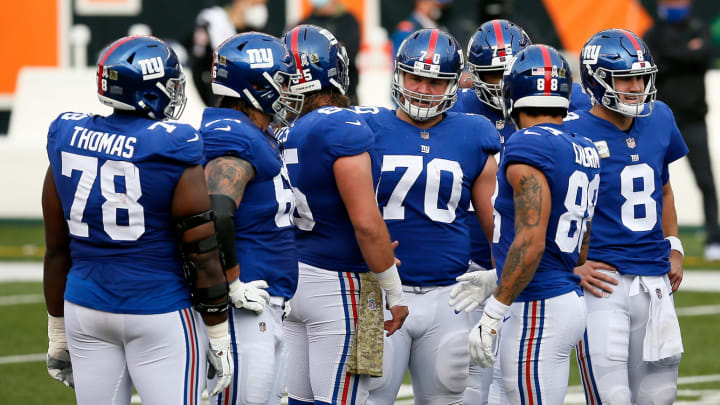Takeaways From Giants’ 2020 Season That Could Echo Into Offseason

At first blush, the New York Giants' 6-10 record doesn't look any better than their 5-11 record from two years ago and certainly not from their 4-12 mark in 2019. But head coach Joe Judge's team showed a lot to be encouraged over, starting with its season-long competitiveness --with two exceptions, the team was never really out of any game, and at no point did the players quit on the program--through their buy-in.
But there were a few season-long issues that the Giants couldn't overcome, issues that they'll have to address this off-season, be it with a tweak to the system they ran in 2020 or through their personnel.
Here's one last look at some macro stats and trends from the 2020 season that held the Giants back from being a competitive team.
RELATED:
- John Mara, Dave Gettleman Pledge Support for Daniel Jones Despite Disappointing Season
- A Look at the Giants' Biggest Miscalculations from 2018 and Why They Stalled Progress
Offensive Scoring
High atop on Judge's "to do" list, this off-season is the scoring issue, and it's probably not even close. The Giants averaged 17.5 points per game, 31st in the NFL, and only higher than the Jets' 15.2 points per game.
There were many reasons behind the Giants' struggles to score, some of which included 31 stalled scoring drives due to penalties, dropped passes (29), third-down down offense (36.6%, 29th), and red zone performance (46.34%, 31st).
That the Giants' average scoring margin was -4.8 (24th in the league) is a testament to the defense's play, which kept them in some close games that the Giants otherwise had no business still being in.
Both general manager Dave Gettleman and team co-owner John Mara have already confirmed the obvious, that playmakers will be a top priority, as it should be.
Although the team's brass has endorsed quarterback Daniel Jones as its franchise signal-caller of the future, Jones' production has bordered on middle to bottom third of the pack among quarterbacks in the league.
Not all of that is on Jones, though, as his supporting case left much to be desired. With that all-important third year on the horizon for Jones, the Giants need to surround this guy with better talent if they want people to buy in on Jones being the future at quarterback.
Offensive Drive Success Rate
Football Outsiders has a metric called "Drive Success Rate" (DSR), which measures how successful an offense was in either scoring or converting a first down. Not surprisingly, the Giants offense ranks 29th overall in this metric, with sub rankings of 27th in yards/drive and 29th in points per drive.
There are many reasons behind the Giants' low placement on this metric. Still, some of the most glaring include dropped passes (Jones's receivers had 29 drops, the seventh most among quarterbacks who took a minimum of 50% of their team's snaps) and 167 first downs (11th lowest total among the sample group).
From a passing perspective, think how much better Jones's final stat line would have been if his receivers didn't drop 6.5% of his pass attempts or if his offensive line was a little better at the beginning in keeping defenders from hitting him as he threw the ball those 15 times.
Per PFF, who measures these stats, Jones had a 74.8% adjusted passing completion, which isn't too shabby at the end of the day. So think about what some improvement among his playmakers and offensive line in 2021 might bring for the soon-to-be third-year quarterback.
Negative Plays
The Giants ran 966 plays on offense in 2020, the third-fewest in the league behind Houston (940) and the Jets (948). So when a team doesn't have as many opportunities, it probably would behoove them to optimize as many of those changes as possible.
But this is yet another area in which the Giants can use some improvement. According to a data search query run on the NFL Savant, the Giants generated 77 plays (run and pass) of zero or negative yardage, 8% of their total. (Note: The query did not include turnovers or plays wiped out or set back by penalties.)
In terms of where the Giants finished in the league, they tied for 11th place (with Dallas, Cincinnati, and Atlanta) for the highest percentage (8%) of plays with zero or negative yardage, their 77 plays for zero or negative yardage tying them for 15th with the Ravens.
There are several reasons behind that statistic, but this is yet another reason why the Giants have struggled to score as you can't score points if you're not moving forward on four scoring drives.

Patricia Traina has covered the New York Giants for 30+ seasons, and her work has appeared in multiple media outlets, including The Athletic, Forbes, Bleacher Report, and the Sports Illustrated media group. As a credentialed New York Giants press corps member, Patricia has also covered five Super Bowls (three featuring the Giants), the annual NFL draft, and the NFL Scouting Combine. She is the author of The Big 50: The Men and Moments that Made the New York Giants. In addition to her work with New York Giants On SI, Patricia hosts the Locked On Giants podcast. Patricia is also a member of the Pro Football Writers of America and the Football Writers Association of America.
Follow Patricia_Traina